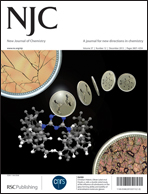Modeling the cysteamine catalyzed cysteine proteinases using DFT: mechanistic insights into the hydrolysis of acetyl-p-nitroanilide†
Abstract
The hydrolysis of the peptide bond of acetyl-p-nitroanilide catalyzed by cysteamine, mimicking the catalysis of cysteine proteinases, has been studied by means of DFT electronic structure calculations in the gas phase and in aqueous solution. Accordingly, four plausible reaction profiles were considered as follows: (a) a general-acid/general-base (GA/GB), (b) a concerted, (c) a stepwise nucleophilic and (d) a concerted nucleophilic mechanism. Among these four reaction mechanisms, the concerted nucleophilic one followed by that of hydrolysis is predicted to be kinetically the more feasible in the gas phase having the lower activation barrier in line with previous experimental as well as theoretical studies. Solvation introduces substantial changes in the energetic profiles which are accompanied by modifications of geometry parameters of the stationary points. From the comparison of the energetic profiles of the explored reaction pathways in solution it is concluded that the concerted GA/GB mechanism is the preferred one having the lowest activation barrier of 20.9 kcal mol−1.


 Please wait while we load your content...
Please wait while we load your content...